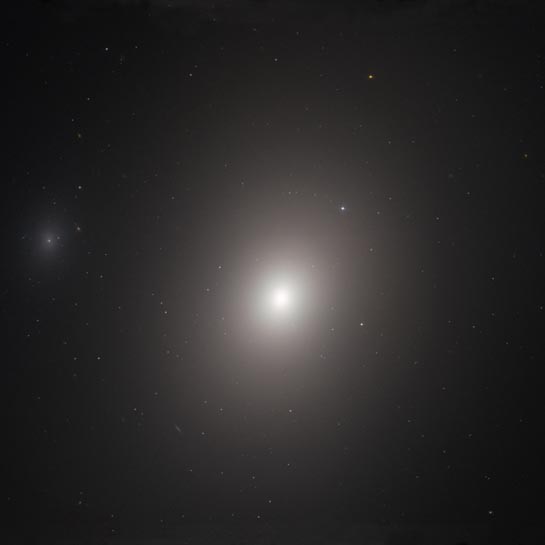
Elliptical galaxy
RA 12h 26m 11.47s Dec 12° 56' 53.66"
Virgo
50 million light-years
9.8
8.9' × 5.8'
3.24 x 2.89 arcminutes
North is 37.7° left of vertical
ESA/Hubble & NASA, P. Cote et al.
September 23, 2019
ABOUT
THIS IMAGE:
This image from the NASA/ESA Hubble Space Telescope shows the galaxy Messier 86. Despite its being discovered over 235 years ago by astronomer Charles Messier, the morphological classification of Messier 86 remains unclear; astronomers are still debating over whether it is either elliptical or lenticular (the latter being a cross between an elliptical and spiral galaxy).
Messier 86 is part of the Virgo Cluster of galaxies and is situated about 50 million light-years from Earth. The galaxy is moving through space remarkably quickly - its current trajectory is bringing it in our direction, back towards the center of its cluster from the far side, at the incredible speed of over 875,000 kilometers per hour! Because of the speed with which it is moving through the cluster, Messier 86 is undergoing a process known as ram-pressure stripping; the resistive material filling the gaps between individual cluster galaxies is pulling at the gas and dust in Messier 86 and stripping them out as the galaxy moves, creating a long trail of hot gas that is emitting X-ray radiation.
Astronomers are using Hubble observations such as this to study elliptical and lenticular galaxies, both of which are often found at the centrer of galaxy clusters. By studying the cores of these galaxies, astronomers hope to determine details of the central structure and to analyze both the history of the galaxy and the formation of its core.
From Wikipedia:
Messier 86 (also known as M86 or NGC 4406) is an elliptical or lenticular galaxy in the constellation Virgo. It was discovered by Charles Messier in 1781. M86 lies in the heart of the Virgo Cluster of galaxies and forms a most conspicuous group with another large galaxy known as Messier 84. It displays the highest blue shift of all Messier objects, as it is approaching the Milky Way at 244 km/s. This is due to its falling towards the center of the Virgo cluster from the opposite side, which causes it to move in the direction of the Milky Way.
Messier 86 is linked by several filaments of ionized gas to the severely disrupted spiral galaxy NGC 4438 and shows some gas and interstellar dust that may have been stripped of it like the one present in those filaments. It is also suffering ram-pressure stripping as it moves at high speed through Virgo's intracluster medium, losing its interstellar medium and leaving behind a very long trail of X ray-emitting hot gas that has been detected with the help of the Chandra space telescope.
Messier 86 has a rich system of globular clusters, with a total number of around 3,800. Its halo also has a number of stellar streams interpreted as remnants of dwarf galaxies that have been disrupted and absorbed by this galaxy.
From NASA:
Located in the constellation Virgo, M86 is either an elliptical galaxy or a lenticular galaxy (a cross between an elliptical and spiral galaxy). This Hubble observation of M86 was taken in near-infrared and visible light using the Wide Field and Planetary Camera 2 and the Advanced Camera for Surveys. Featuring about half of the galaxy, it shows the bright central nucleus and surrounding regions of light. The image also reveals globular clusters in M86 (shown as points of light) and an edge-on galaxy (found to the lower left of M86's core).
M86 was discovered in 1781 by Charles Messier and is one of the brightest members of the Virgo cluster of galaxies. It contains approximately 3,800 globular clusters.
While the majority of the Virgo cluster is receding from the Milky Way, M86 is getting closer to our galaxy. This is because M86 is located on the far side of the Virgo cluster from us and is moving toward the center of the cluster. Of all the galaxies in Messier's catalog, M86 is moving the fastest in our direction but is still approximately 52 million light-years away from Earth.
The best time of the year to view M86 is during May. Having a magnitude of 9.2, M86 can be seen near fellow galaxies in the Virgo cluster with binoculars and small telescopes, with M84 often appearing alongside M86 in the field of view. Telescopes that are 8 inches or larger will reveal several other, fainter galaxies in the same field of view.
Hubble took these observations to help astronomers study the cores of early-type galaxies, which are often old elliptical or lenticular galaxies found toward the centers of galaxy clusters. By studying the cores of these galaxies, astronomers can determine their central structure and analyze both the history of the galaxy and the formation of its core.